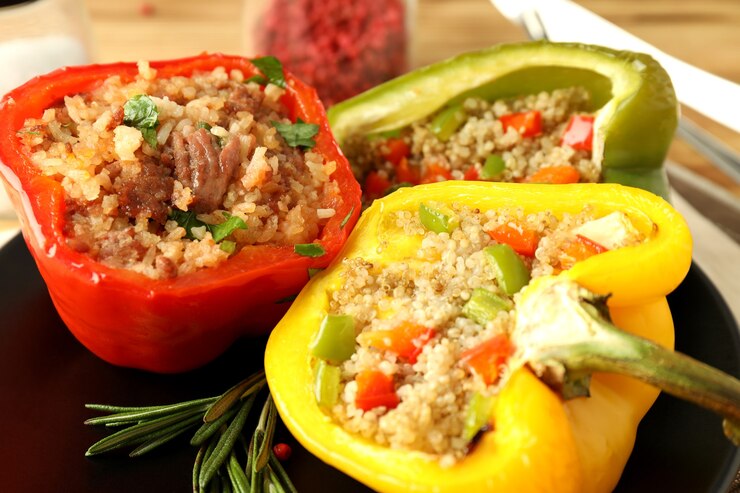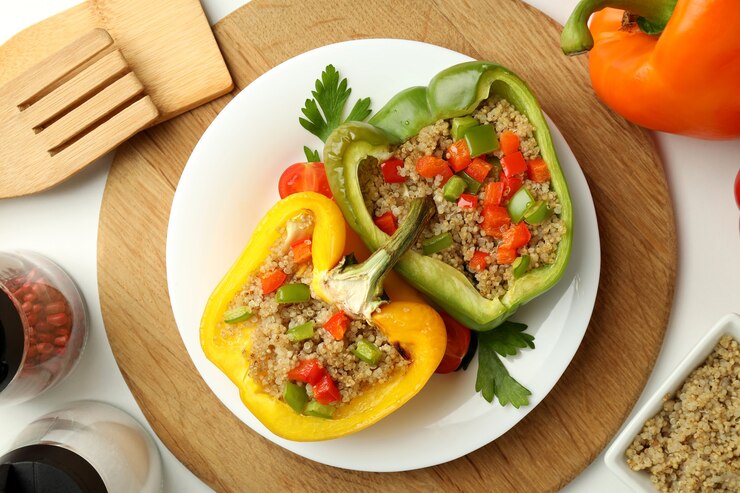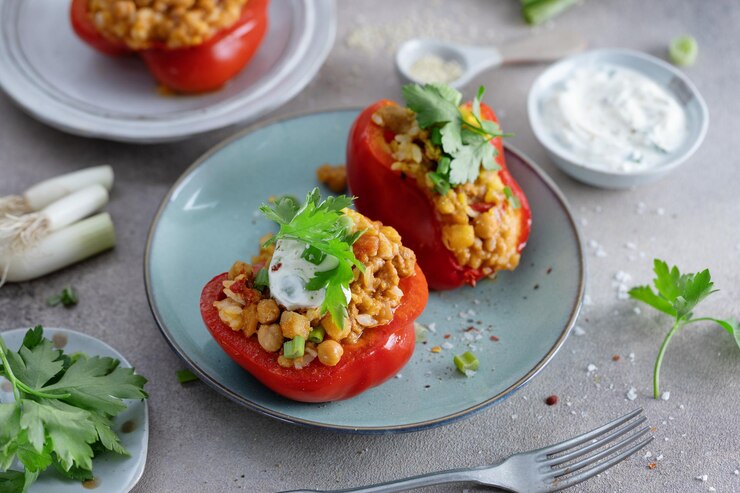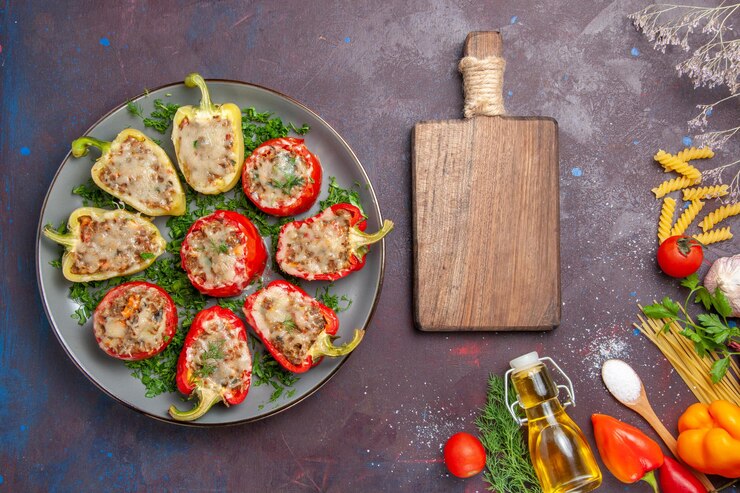Vegan stuffed bell peppers are a delicious and satisfying plant-based meal. These vibrant peppers are filled with a flavorful mixture of vegetables, grains, and legumes, creating a hearty and wholesome dish. Whether you opt for a classic filling with rice and beans, explore Mediterranean flavors with lentils and herbs, or embrace a meaty texture with Beyond Meat, there’s a vegan stuffed pepper recipe to suit every taste.
Ready to ditch the meat and embrace the vibrant flavors of plant-based cooking? This article will guide you through a variety of vegan stuffed peppers recipes, from simple and classic to creative and unique. Discover how to make vegan stuffed peppers with rice, vegan stuffed peppers with rice and beans, vegan stuffed peppers with tomato sauce, and even explore meat-free alternatives like vegan stuffed peppers with Beyond Meat or vegan stuffed peppers with lentils. Whether you’re a seasoned vegan or simply curious about plant-based cuisine, these recipes are sure to inspire and delight.
Vegan Stuffed Bell Peppers Recipe
Here’s a delicious recipe for vegan stuffed bell peppers.
Ingredients:
- 4 large bell peppers (any color, tops cut off and seeds removed)
- 1 cup cooked quinoa
- 1 can (15 oz) black beans, drained and rinsed
- 1 cup corn kernels (fresh, frozen, or canned)
- 1 small onion, finely chopped
- 2 cloves garlic, minced
- 1 can (14.5 oz) diced tomatoes, drained
- 1 teaspoon cumin
- 1 teaspoon chili powder
- 1/2 teaspoon paprika
- 1/4 teaspoon cayenne pepper (optional, for a little heat)
- Salt and pepper to taste
- 1/4 cup fresh cilantro, chopped
- 1/4 cup nutritional yeast (optional, for a cheesy flavor)
- Olive oil for sautéing
Preparation Time: 15 minutes
Cooking Time: 45 minutes
Total Time: 1 hour
Servings: 4 bell peppers (one pepper per serving)
Step 1: Prepare the Bell Peppers
Preheat your oven to 375°F (190°C). Cut the tops off the bell peppers and remove the seeds and membranes. Place the bell peppers in a baking dish, cut side up, and set aside.
Step 2: Cook the Filling
In a large skillet, heat a drizzle of olive oil over medium heat. Add the chopped onion and garlic, and sauté until softened, about 5 minutes. Add the cooked quinoa, black beans, corn, diced tomatoes, cumin, chili powder, paprika, and cayenne pepper (if using). Stir to combine and cook for another 5-7 minutes. Season with salt and pepper to taste.
Step 3: Stuff the Bell Peppers
Carefully spoon the quinoa mixture into the prepared bell peppers, packing the filling down slightly as you go. Fill each pepper to the top.
Step 4: Bake the Bell Peppers
Cover the baking dish with aluminum foil and bake in the preheated oven for 30 minutes. Remove the foil and bake for an additional 10-15 minutes, or until the bell peppers are tender and slightly browned on the edges.
Step 5: Add Finishing Touches
Once the peppers are done baking, remove them from the oven and let them cool slightly. Sprinkle the tops with chopped fresh cilantro and nutritional yeast, if desired.
The total cost for this recipe can vary based on the prices of ingredients in your location. Here is a rough estimate of the cost:
- Bell Peppers: $4.00 (around $1.00 per pepper)
- Quinoa: $1.50 (for 1 cup)
- Black Beans: $1.00 (for one 15 oz can)
- Corn: $0.75 (for 1 cup)
- Onion and Garlic: $0.50
- Diced Tomatoes: $1.00 (for one 14.5 oz can)
- Spices and Olive Oil: $1.00
- Cilantro and Nutritional Yeast: $1.50
Total Estimated Cost: Approximately $11.25
This cost is based on average prices in the United States and may vary in your region.
Enjoy your flavorful Vegan Stuffed Bell Peppers! They’re perfect as a main course or a side dish. ️
Storage and Reheating Instructions
Here’s how to store and reheat your vegan stuffed bell peppers to keep them fresh and tasty:
Storage:
Refrigerator: Allow the stuffed peppers to cool to room temperature. Place them in an airtight container or wrap them individually in aluminum foil. They will last for up to 4 days in the refrigerator.
Freezer: To freeze, wrap each stuffed pepper tightly in plastic wrap, then in aluminum foil, or place them in a freezer-safe container. They can be stored in the freezer for up to 3 months.
Reheating:
Microwave: Place the stuffed pepper on a microwave-safe plate. Cover it with a damp paper towel to retain moisture. Heat on high for 2-3 minutes or until heated through. If frozen, microwave for 4-6 minutes, checking halfway to ensure even heating.
Oven: Preheat your oven to 350°F (175°C). Place the stuffed peppers in an oven-safe dish and cover with aluminum foil. Bake for 15-20 minutes or until heated through. If frozen, bake for 25-30 minutes.
Stovetop: Place the stuffed pepper in a skillet with a splash of water or vegetable broth. Cover and heat over medium-low heat for 10-15 minutes, turning occasionally, until heated through.
Dietary Information
Here’s the dietary information for the vegan stuffed bell peppers:
- Vegan: Yes, this recipe is completely plant-based and suitable for a vegan diet.
- Gluten-Free: Yes, this recipe is naturally gluten-free, as it doesn’t contain any wheat, barley, or rye.
- Keto: No, this recipe is not suitable for a keto diet due to the higher carbohydrate content from ingredients like quinoa, black beans, and corn. For a keto-friendly version, you could consider substituting these with lower-carb options such as cauliflower rice and additional vegetables.
This recipe is also rich in fiber, vitamins, and minerals, making it a nutritious choice for many dietary preferences!

History of Vegan Stuffed Bell Peppers
The history of stuffed bell peppers is quite fascinating and spans across various cultures! While the exact origins are unclear, stuffed peppers have been a part of culinary traditions for centuries. Many cultures have their own versions of stuffed peppers, such as Spain’s “Pimientos Rellenos de Arroz con Salsa de Tomates” and India’s “Bharawn Shimla Mirch.”
The modern stuffed bell pepper recipe, as we know it today, started appearing in American cookbooks around the 1890s. The Boston Cooking-School Cook Book from 1896 included variations of the dish. Different countries have their own take on stuffed peppers, such as Hungary’s “Toltott Paprika” with ground meat and paprika, and Mexico’s “Chile Rellenos” with carnitas meat.
The vegan version of stuffed bell peppers has gained popularity in recent years as people seek healthier and more sustainable food options. It’s a creative twist on the classic dish, using plant-based ingredients like quinoa, beans, and vegetables.
Stuffed bell peppers have truly stood the test of time, evolving with culinary trends and dietary preferences. It’s amazing to see how a simple bell pepper can be transformed into a delicious and nutritious meal across different cultures!
Nutrition Facts
Here’s a detailed nutritional breakdown for one serving of vegan stuffed bell peppers. Please note that these values are approximate and can vary based on specific ingredients and quantities used.
| Nutrient | Amount per Serving |
| Calories | 250 kcal |
| Total Fat | 5 g |
| Saturated Fat | 0.5 g |
| Cholesterol | 0 mg |
| Sodium | 400 mg |
| Total Carbohydrates | 45 g |
| Dietary Fiber | 10 g |
| Sugars | 8 g |
| Protein | 10 g |
| Vitamin A | 120% DV |
| Vitamin C | 150% DV |
| Calcium | 6% DV |
| Iron | 15% DV |
DV stands for Daily Value, which indicates how much a nutrient in a serving of food contributes to a daily diet. These values are based on a 2,000-calorie daily intake.

Other Vegan Stuffed Bell Peppers Recipes
Here’s a comparison of the different variations of vegan stuffed bell peppers:
Vegan Stuffed Peppers with Rice
This variation uses rice instead of quinoa. Brown rice, white rice, or even wild rice can be used. Rice provides a slightly different texture and flavor profile compared to quinoa. It’s more traditional and hearty.
Vegan Stuffed Peppers with Rice and Beans
This version includes both rice and beans, adding an extra layer of protein and fiber. Combining rice with beans creates a satisfying and filling meal. The beans add a creamy texture, while the rice offers a chewy bite.
Vegan Stuffed Peppers with Tomato Sauce
In this variation, the stuffing is often cooked in a tomato sauce or topped with tomato sauce before baking. The tomato sauce adds a rich, tangy flavor and keeps the filling moist. It can also contribute additional nutrients like vitamin C.
Vegan Stuffed Peppers with Beyond Meat
This alternative uses Beyond Meat (a plant-based meat substitute) in the filling. Beyond Meat provides a meat-like texture and flavor, making it a great choice for those transitioning to a plant-based diet or craving a meatier option. It adds substantial protein content as well.
Vegan Stuffed Peppers with Lentils
This recipe incorporates cooked lentils into the stuffing mixture. Lentils add a hearty and earthy flavor, along with plenty of protein and fiber. They provide a slightly different texture compared to beans, being both firm and tender.
Each of these variations offers a unique twist on the classic vegan stuffed bell pepper, catering to different tastes, textures, and dietary needs. Enjoy experimenting with these different versions!
Can vegans eat peppers?
Absolutely! Vegans can definitely eat peppers. In fact, peppers are a popular ingredient in vegan diets because they are versatile, flavorful, and nutritious. They are packed with vitamins, antioxidants, and fiber, making them a great addition to a variety of dishes, from salads and stir-fries to soups and stuffed peppers like the ones we’ve been discussing.
What does stuffed bell peppers mean?
Stuffed bell peppers are a delightful dish where bell peppers are filled with a variety of ingredients. The peppers are typically hollowed out by removing the seeds and membranes, and then they’re filled with a mixture of grains, vegetables, beans, or even plant-based meats.
The filling can vary widely depending on the recipe and the cook’s preferences, which is why there are so many delicious variations, such as those with rice, beans, quinoa, lentils, or plant-based meat substitutes like Beyond Meat.
Once filled, the peppers are usually baked until they’re tender and the filling is heated through. This dish is not only visually appealing but also packed with nutrients and flavors, making it a popular choice in many cuisines around the world.
What pairs well with stuffed peppers?
Stuffed peppers are a delightful dish, bursting with flavors and texture! Here are some wonderful options to complement your stuffed peppers:
- Green Salad: A fresh, crisp salad with mixed greens, cucumbers, tomatoes, and a light vinaigrette is a perfect side.
- Garlic Bread: Who can resist warm, buttery garlic bread to accompany a savory meal?
- Quinoa: A light quinoa salad with veggies can add a nutritious and tasty touch.
- Roasted Vegetables: Roasting some seasonal veggies like zucchini, carrots, and Brussels sprouts can provide a delightful, crunchy side.
- Mashed Potatoes: Creamy mashed potatoes are always a comforting side option.
- Soup: A light soup, like tomato basil or a simple chicken broth, can start the meal off nicely.
Should peppers be precooked before stuffing?
You don’t have to, but it can be helpful! Precooking peppers before stuffing them can ensure they’re tender and flavorful. Precooking makes the peppers softer, reducing the risk of them being too crunchy after baking. Cooking them briefly can enhance their natural sweetness. It can reduce overall baking time, ensuring both the peppers and stuffing are perfectly cooked.
To precook them, you can blanch the peppers in boiling water for a few minutes or microwave them until slightly tender. Just be careful not to overcook them, or they might become too soft to hold the stuffing.

Final Thoughts
Vegan stuffed bell peppers offer a versatile and delicious way to enjoy a hearty and wholesome meal. With endless possibilities for customization, you can easily tailor these recipes to your own preferences and dietary needs. Whether you’re looking for a comforting weeknight dinner or an impressive dish for a special occasion, these plant-based creations are sure to satisfy. So, get creative in the kitchen, experiment with different flavors and ingredients, and savor the deliciousness of these vibrant and flavorful vegan stuffed bell peppers. I hope this article has inspired you to explore the world of plant-based cooking and discover the joy of creating delicious and satisfying meals without compromising on flavor.









